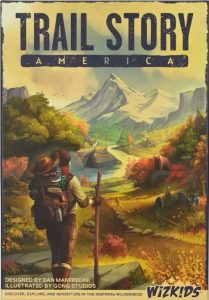 Prior to Gen Con 2024, the BGQ staff put together a list of our most anticipated games that would be available at the con. After scouring the list, I chose Trail Story: America. I like games that leave players free to explore and make discoveries, with a narrative emerging organically as they do so, and this game seemed to offer just that.
Prior to Gen Con 2024, the BGQ staff put together a list of our most anticipated games that would be available at the con. After scouring the list, I chose Trail Story: America. I like games that leave players free to explore and make discoveries, with a narrative emerging organically as they do so, and this game seemed to offer just that.
In Trail Story: America players are wanderers trekking across the wilderness of 1930s America. The game is for 2-4 players and lasts 90-120 minutes.
Gameplay Overview:
The game board is made up of a square grid with each square representing one of four terrain types: mountain, river, forest, and meadow. During setup, several story tokens are drawn from a bag and placed on marked borders between these locations. There are four different types of story tokens, and each will have 1-3 stars on it, indicating that encounter’s difficulty level.
Additionally, each player has their own player board, which is where they track their skills: intelligence, strength, and agility, as well as store memories (gained from encounters), collected items such as food, and inspiration crystals.

On a player’s turn they take one of the five possible actions:
- Scout – draw a story token from the bag for each border along their space that does not already have a story token. This also gives the player experience cubes, which can be spent later during the reflection action.
- Travel – Move up to your maximum movement along paths containing at least one story token. When a player moves they must choose one story token they passed over and place it in front of them on the table, then immediately resolve the encounter type depicted by the token.
To do so, draw a card from the deck matching the encounter type, then resolve the card by performing a skill test by rolling dice. The number of dice rolled is determined by how many cubes a player converts into experience from the track for the specified skill, as well as any inspiration crystals they choose to exhaust. The six-sided dice show different amounts of stars on each face, ranging from zero to two.
To successfully pass a test you must roll the number of stars indicated by the story token (1-3). Passing will often gain the player some benefit, and failing may either have no consequences or result in a penalty, such as taking a despair card which may reduce points at game’s end. Either way, after resolving the challenge, the player collects the encounter card and moves the story token to a stored memories space. - Journal – Spend collected story tokens in order to place story cards you’ve gained from encounters under your journal. Cards tucked under your journal will each score a point at the end of the game.
- Camp – During this action a player will draw a camp card and gain the listed benefits: usually this includes eating, which is a way for players to replenish their skill cubes (which, as mentioned above, can be converted to experience to roll dice during tests). If other players are close enough, they can also move to the campsite to gain a benefit, or multiple benefits if they give the camper one of their story cards.
- Reflect – Players spend their experience in order to move wanderlust (compass) tokens from their board, thus freeing up additional storage spaces, to the main board. Doing so creates a haven at that player’s current location. Having havens in specific terrain types gives the player permanent benefits associated with that terrain type for the rest of the game.
The game continues, with players taking one of the above actions each turn. Once the game end is triggered, each player takes one more turn, then points are tallied to determine the winner.
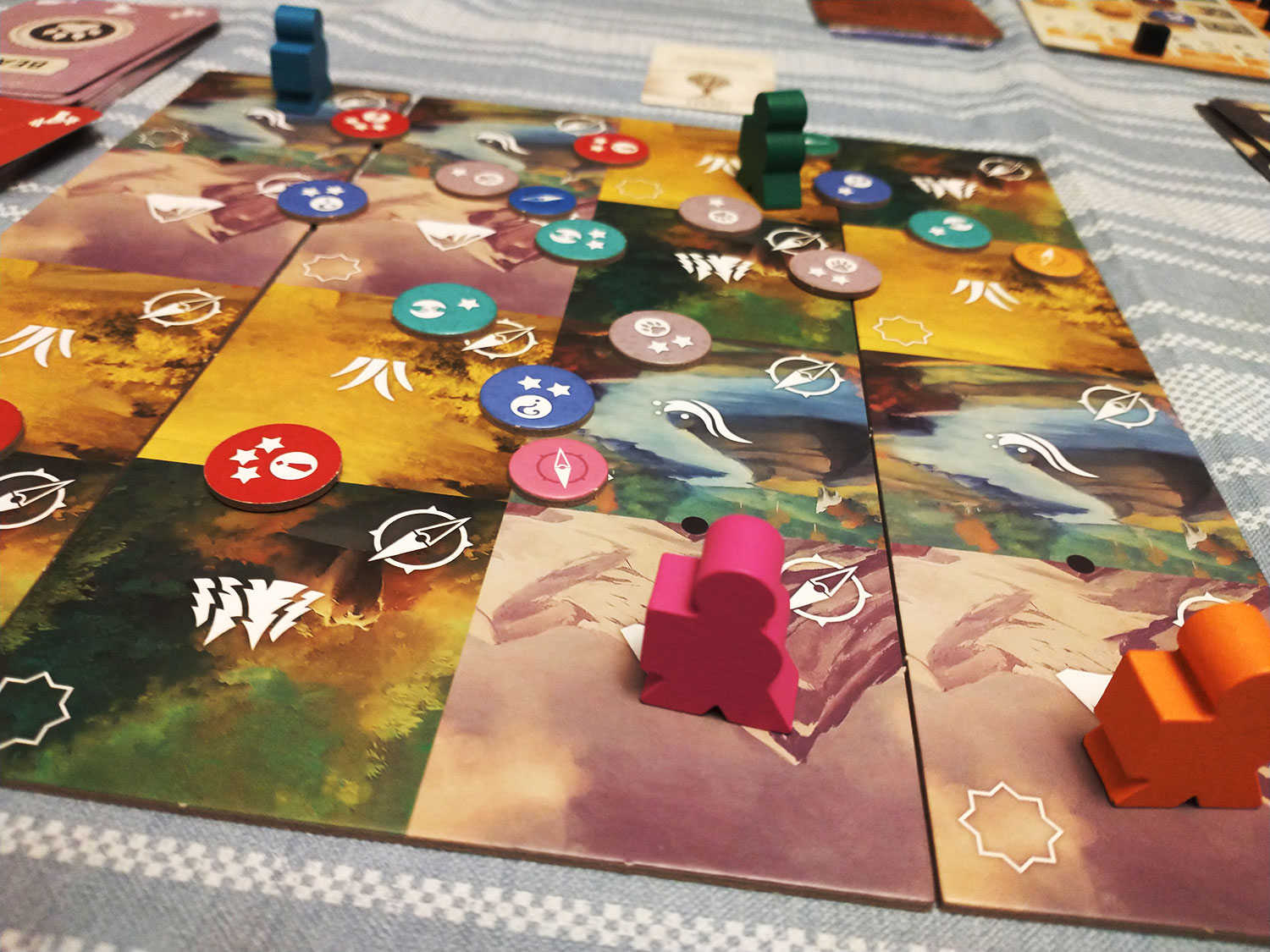
Game Experience:
Trail Story lived up to my expectations of a narrative game with an emergent story. It’s fun to see how the cards interact with each other, and how one card sometimes leads to another, such as when I drew a card called “Rustling Leaves” which led to drawing another card and discovering a deer. I could have pursued the deer for food, but chose instead to pet it.
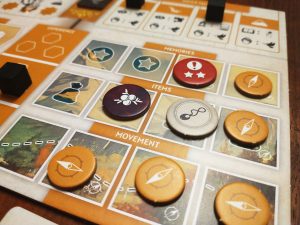
When you join another player’s campsite you can “share stories” by giving them one of your story cards. It’s fun to imagine sitting around a campfire talking about that time you met a carnival worker at a traveling circus who taught you to brawl. When you learn from a “Friend” card you gain a skill that stays with you throughout the game, reminding you of that interaction. Other cards might give you items you can carry with you, offering benefits throughout the game. Sometimes even failure can restore your hope, and hope can be used to automatically succeed in a later test. Drawing inspiration from memories of your parents or remarkable places you’ve visited will also help you succeed. Skills converting to experience, and experience leading to better skills makes complete thematic sense.
But what about the actual mechanics of the game? How does all that theme translate into gameplay? Here is where we have some hits and some misses. For a game that is relatively light in terms of gameplay, the rules aren’t always intuitive or clear. For the most part, the examples given in the rulebook helped clarify where I had doubts, but I felt some details, especially concerning end of game scoring, could have been explained better, and it would have been nice to have a FAQ section at the back of the rulebook.
The function of the cubes in the game is also somewhat fiddly and confusing. It’s hard to remember details like how you actually get more cubes in your skill area (by eating during a camp action), and then those skill cubes move into your experience area when you roll dice, to later be spent to create havens.
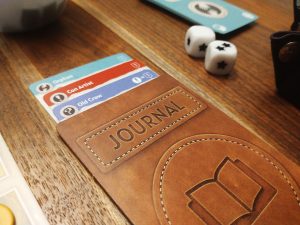
But each skill area can only hold three cubes, so if you move a cube over when it’s already full, that cube is simply lost, which plays into having to time your actions right, but I’m not sure I liked how it all came together. It works, but left me feeling like it could have been cleaner and more fleshed out. The rules also mention that, when you create your first haven for a specific terrain type, you use a cube to mark the haven box on your board, but there isn’t really a good place to put that cube without covering up useful icons.
Another area in which I have my doubts is the replay value of this game. I would have liked to see more board configurations and more variety in the cards. While a different story will unfold every time, after playing a couple of times you will already recognize a lot of the cards. I think this will matter more to some than others. For some, just the pleasure of experiencing the game will be enough to carry it through multiple sessions, but others may find they want more in terms of gameplay depth and variety. The luck factor might also be a deterrent for some, as nearly every test comes down to a dice roll. You can do some things to mitigate that luck, and if you work it out and plan ahead things usually work in your favor, so I didn’t mind that this game leaned a little on the lucky side, but I know that will bother some.
Besides that, many of the mechanisms were fun and made sense. Encounters might lead to other encounters, creating an interesting little story, then those encounters become memories you might journal about later, or share around a campfire. It’s fun to look at your board at the end of the game and see the story you’ve created and the skills you’ve accumulated. More fun, in fact, than actually scoring the game, which feels a little anticlimactic and just comes down to icons on the journal cards.
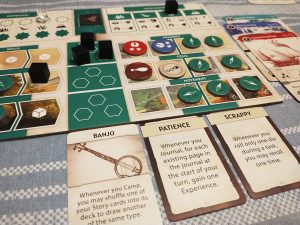
Finally, I think the game runs a bit long for what it is, especially with four players. A two player game can be pretty quick, but adding more players didn’t really feel like it added anything to the game in terms of immersion, only in terms of length since the end condition remains the same. Honestly, I feel like it should have been made with solo play in mind. It’s the sort of game I would prefer to play solo, so it felt strange that the rules didn’t even mention that. There is some interaction between players with the camp action and racing to create havens in some areas, but not really enough to feel like an interactive game. It almost feels cooperative, though it isn’t. As someone who likes to play nice, I didn’t mind that, but just wish there were solo rules besides playing multi-handed.
Final Thoughts:
After all of that, my feelings on Trail Story: America are mixed. I very much like the story building and the thematic touches. I think this game makes a good effort to couple interesting mechanisms with intriguing story-building, but for me, it fell just short of my expectations.
Game length, some fiddly issues and confusing or sometimes uninteresting rules all bring it down a few degrees. For those purely interested in Trail Story: America for the story aspect, those who want to just sit and be immersed in the experience while mechanisms step aside, this is a great game. It’s low-stress and overall quite friendly and gracious in terms of scoring and interactions. But if you’re a gamer who puts mechanisms before theme, a lot of the appeal might be lost, as it’s less engaging when you’re just going through the motions and playing for the win. This game is about the journey, not the destination, which is either its saving grace or its detriment, depending on your preferences.
Final Score: 3 stars – An engaging, story-driven game that is worth trying if you’re a fan of the genre
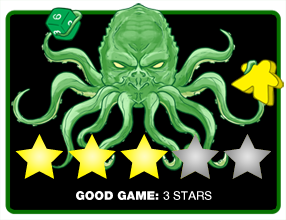 Hits:
Hits:
• Thematic and immersive
• Gives the sense of creating something unique at the end
• Interesting skills and ways to mitigate luck
Misses:
• Can run a bit long with four players
• Confusing and fiddly rules hinder gameflow
• Luck of the roll may be a turnoff for some
Source: Board Game Quest



